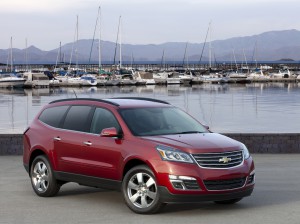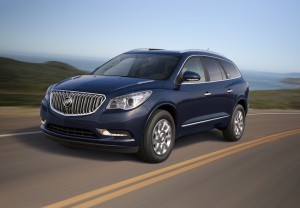
GM's put a stop-sale order on its 2016 large crossovers due to incorrect mileage figures on the window sticker.
General Motors has been hit with a proposed class action lawsuit over changes to its fuel economy calculations for three different vehicles as questions about its mileage claims continue to grow to nearly 2 million vehicles.
The expansion comes, in part, as Consumer Reports magazine suggests that the automaker has been incorrectly stating the mileage in these vehicles for several years. GM’s problems come on the heels of recent admissions by Suzuki, a former manufacturing partner of GM, and Mitsubishi that they had been skirting the system as well.
The plaintiffs in the suit against GM, which was filed in Southern California, claim the apparently “fudged” numbers ding their wallets not only at the gas pump, but also in the value the vehicles.
GM circulated a memo to its authorized dealerships on Friday alerting them that its 2016 Chevrolet Traverses, 2016 Buick Enclaves and 2016 GMC Acadias are rated at 15 miles per gallon in city driving and 22 miles per gallon.
(GM halts sales of large crossovers to correct mileage numbers. For more, Click Here.)
The company also issued a stop-sale order calling for those models not to be sold until a correction could be made to the vehicle’s window stickers. GM is concerned that the stickers overstate fuel economy ratings by 1 to 2 mpg.

The mileage for the Buick Enclave may have been listed inaccurately by GM for years, according to Consumer Reports.
A GM spokesman told Consumer Reports that the automaker is in the process of updating those figures in advertising materials, marketing and websites, in addition to the window stickers on about 60,000 crossovers currently on dealer lots.
However, Consumer Reports said in a new report issued this week that there may be more to the story. After examining its own historical test data next to fuel economy numbers from the Environmental Protection Agency and GM, it’s possible that the stated figures for the Enclave, Traverse, Acadia and also the discontinued Saturn Outlook may have been incorrect for years and the fuel economy on as many as 2 million vehicles has been misstated.
The report comes as Suzuki, which ended sales in the U.S. in 2010, confirmed it evaded emission regulations and Nissan used a burgeoning scandal at Mitsubishi, where executives acknowledged cheating on mileage claims, to purchase a controlling stake in its Japanese rivals. Hyundai and Ford also have acknowledged reporting inaccurate fuel-economy numbers to the U.S. Environmental Protection Agency.
(Mitsubishi reveals it rigged mileage numbers on all Japanese models. Click Here for the story.)
For example, the EPA’s site fueleconomy.gov shows the combined city/highway fuel economy for the 2015 Acadia AWD at 19 mpg—that’s two mpg better than the revised numbers on the 2016 model. When asked whether the discrepancy extends to earlier models, a GM spokesman responded via email, saying that the company, “has checked and found no other models or model years were affected.
Consumer Reports described the Enclave, Traverse, and Acadia as “triplets” and noted that all three vehicles are built on the same platform and share the same powertrain—and the 2016 models are not significant refreshes.
After the company updates the stickers for these 2016 crossover vehicles, the prior models from 2007 to 2015 will now all have better stated fuel economy numbers than the new vehicles in GM’s dealerships.
“It seems unlikely that the company would change the powertrain on these carryover models so late in their model cycles in a way that would cause a dramatic, negative impact on fuel economy. When asked about this directly, GM declined to give a specific answer regarding any substantial changes to these vehicles,” Consumer Reports said.
(To see about automakers under fire for bending the truth, Click Here.)
Consumer Reports has previously tested the real-world fuel economy of three prior models of these GM crossovers and found that they performed below their official EPA numbers (data below). While it’s not unusual for our test findings to vary from the EPA figures, the difference is usually just one or two mpg. In Consumer Reports testing, we saw up to a three mpg difference from the EPA figures, the magazine said.

They also misstated the mileages on my 2015 Chevy Colorado. I get better mileages than what they said I would get.